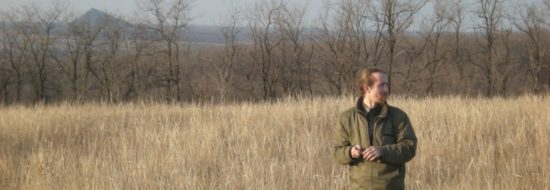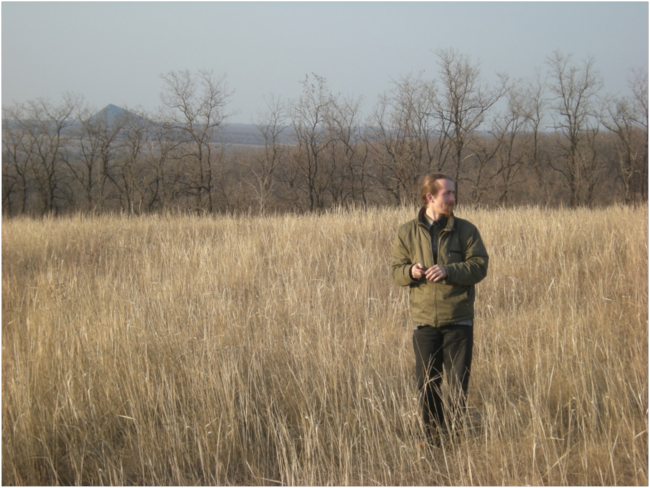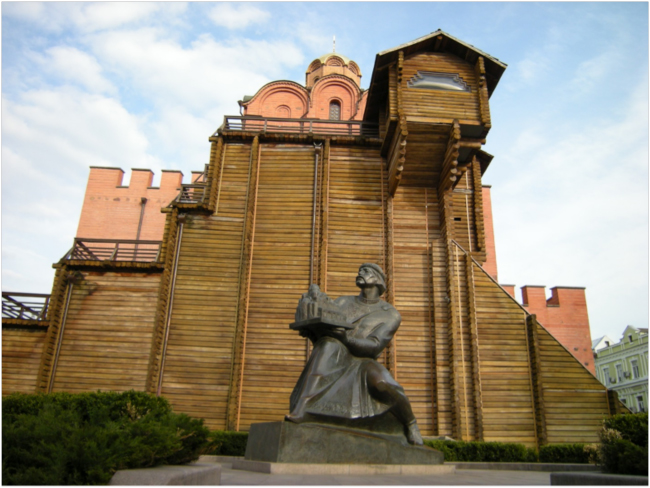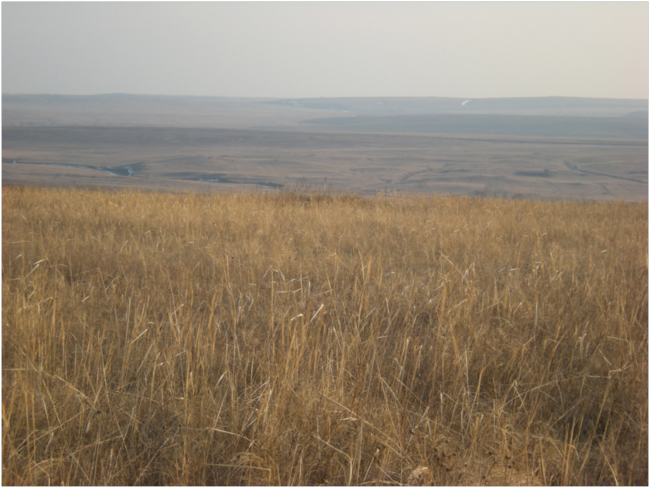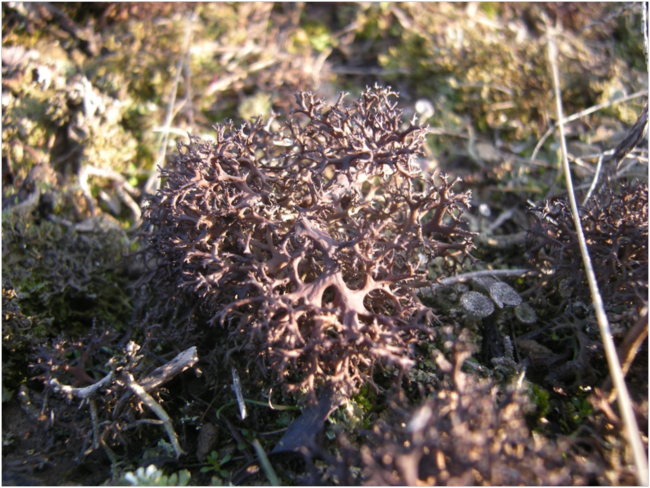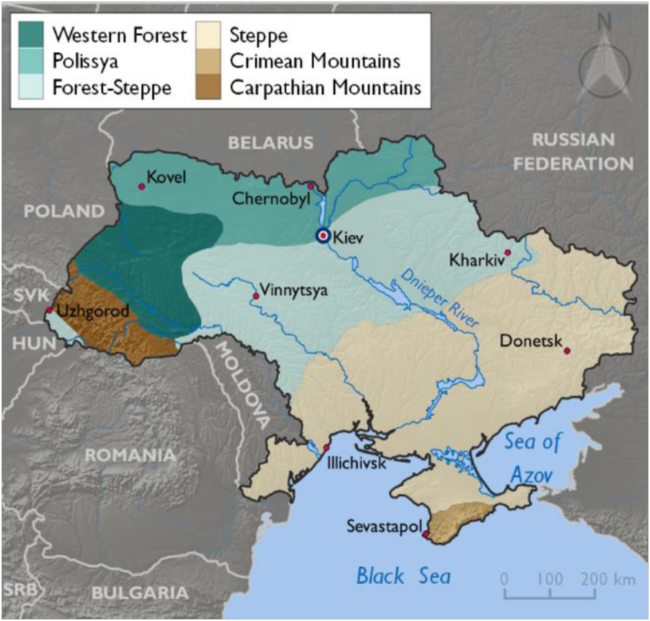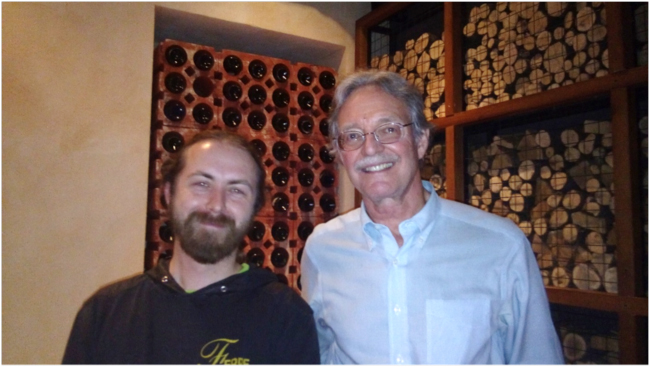April 2017. In my previous story, I described my impressions of another spring on the grasslands of the Ukrainian steppe and explained that this was my second trip to Ukraine to conduct a biodiversity assessment for the U.S. Agency for International Development (USAID). The first was in the spring of 2011, and on that trip our assessment team traveled to eastern Ukraine, an area now under the military control of separatists supported by Russia. In 2011, USAID more or less insisted that we go there, saying that they had very little information or insight about that part of the country. We visited areas of natural steppe grassland, some that were protected in designated protected areas and some that were not. One of those places, still vivid in my mind, is Naholny Krazh.
Naholny Krazh was an unprotected patch of natural steppe on a high ridge somewhere in the Luhansk region. We visited Naholny Krazh in 2011 at the insistence of Oleksiy Vasyliuk, a young biologist and environmental activist, who joined us on the trip because he was such a rich resource for contacts in the region.
In 2014, after the “people power” uprising in Kyiv’s “Maidan,” or Independence Square, which forced Ukraine’s Russian-leaning then-president Viktor Yanukovych out of power, I posted a blog story titled “Ukrainian Spring.” I wrote about our 2011 biodiversity reconnaissance to eastern Ukraine and our visit to Naholny Krazh, saying: “The patches of remaining unplowed steppe were mainly on the ridges – the crags, or “krazh” in Ukrainian and Russian – where the land fell away to the villages and coal mines and towns and black chernozem fields below. Late in the afternoon, after meeting with a village mayor, we drove up and over Naholny Krazh, the largest remaining intact area of steppe vegetation in Ukraine, completely unprotected by the regional and national system of nature reserves. Sixteen species found in this area are in Ukraine Red Book of threatened and endangered species. Oleksiy said this was his “favorite place in Ukraine.” He had once seen wild wolves here, he said. I didn’t know whether to believe him or not. I wanted to.”
Before going up to the Naholny “crags” on that spring afternoon in 2011, we had stopped in the small village of Matviivka to meet with the head of the village council, Mykola Studzuk. A local environmental NGO that Oleksiy worked with had been talking with him for the past four years about Naholny Krazh, which was in the territory of his village. That day, Mr. Studzuk was very formal and serious as we talked in his small, overheated office. We explained that we were conducting an assessment about biodiversity conservation in Ukraine for the U.S. Agency for International Development, and that we were interested in his views about threats to biodiversity here, and his suggestions for how to protect the natural ecosystems in the area.

Meeting in Matviivka Village: Mayor Mykola Studzuk (third from left) with members of the biodiversity assessment team, March 2011
What I hadn’t expected after we explained our objectives for the meeting was his response: He immediately told us that his goal was to make Naholny Krazh into a nature reserve, a protected area of a type called a “zakaznik” in Ukrainian and Russian. The reason, he explained, was that every year big trucks coming from somewhere brought flocks of sheep to the krazh, and foreign shepherds who tended them moved into abandoned barns and buildings in the area. People in Matviivka were afraid of them and afraid to confront them. He told us they were “Kurds from Iran,” and that he didn’t know who authorized this and allowed them to come, but that the trucks came into Ukraine from Russia. At the end of the grazing season, they moved the sheep out again, leaving the steppe of Naholny Krazh overgrazed. We couldn’t judge how much of this was true, but he was obviously disturbed and concerned about the situation. His reason for wanting to make Naholny Krazh a zakaznik seemed to us to have more to do with wanting to gain control over the land uses in his village territory than with a concern for the survival of Ukrainian Red List species, but nevertheless he seemed completely serious, and a zakaznik seemed to offer a win-win situation: local control and biodiversity conservation.
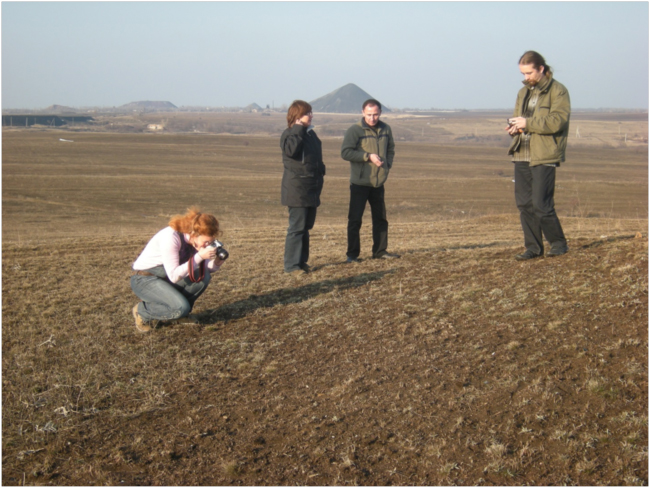
Unprotected and overgrazed site on Naholny Krazh; Alena photographing Cetraria steppe, the endangered steppe lichen, with mountains of coal-mine tailings on the horizon, March 2011
But Mr. Studzuk, a mere village mayor, had not been successful in getting the attention or support of the regional-level authorities, which was needed for the official creation of a zakaznik at Naholny Krazh. That support had to come from the office of the Ukrainian Ministry of Ecology and Natural Resources in Luhansk, the regional capital. We had visited that office the previous day, and the officials there were very formal with us, and seemed uncomfortable with our visit. The legacy of the former Soviet Union was still strong in eastern Ukraine, and I remember being surprised by the huge stained-glass window depicting Lenin in the atrium of the Ministry of Ecology building.
We thanked Mr. Studzuk for his time, gave him our encouragement, and wished him success in protecting Naholny Krazh… but suspected that he would not succeed.
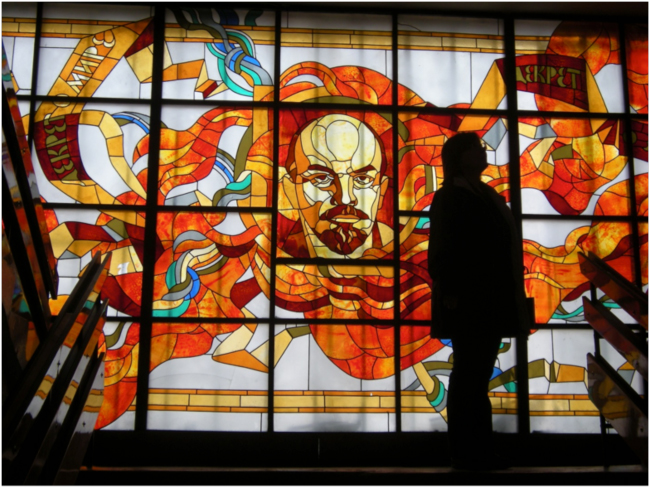
Stained-glass window of Lenin in the main entrance of the regional office of the Ministry of Ecology and Natural Resources, Luhansk Oblast, March 2011
——-
With that background out of the way, I can update the story with information from my recent trip in April 2017. With my Ukrainian biodiversity assessment team members Olga and Alena, I met Oleksiy Vasyliuk again at a Georgian restaurant in the square just below the old gate of Kyiv, the “Great Gate” memorialized musically by the Russian composer Modest Mussorgsky in his 1874 “Pictures at an Exhibition.” Georgian restaurants are all the rage in Kyiv now. As Alena explained, Georgian cuisine is much more interesting than Ukrainian, and both the Ukrainians and Georgians hate the Russians, so Ukraine has welcomed Georgian immigrants who want to open restaurants. I was very happy to see Oleksiy again after six years. We had a lot to catch up on, and the conversation lingered on for a couple of hours.
The most amazing part of the conversation was Oleksiy’s tale of what our 2011 visit to Naholny Krazh had catalyzed. He called the story “Mission American” – a humorous takeoff, he said, on “Mission Impossible,” the title of an America TV and then film series with which he was thoroughly familiar. In his own words, translated by Alena, my colleague on the team, here is what Oleksiy told us:
After our visit to Luhansk region, everyone we met with interpreted our visit in their own way, but nobody believed that we were really interested in biodiversity conservation. They were all worried, and expected that our visit would cause some new problems for them. At Matviivka and some surrounding villages, for the next six months everyone was saying “soon we will all be moved out and a US military base will be built!”
Well, this was after we had campaigned and advocated locally for four years to create a zakaznik to protect Naholny Krazh!
But just six months after our USAID biodiversity assessment team visited the mayor in Matviivka Village, our colleague, Maxim Ponomarev, from a local NGO called “Team of Nature Conservation,” visited the mayor and the village council to try to renew the dialogue on the establishment of a reserve at Naholny Krazh. During that meeting, I got a text message from Maxim that said: “Village Mayor was very nervous because the word ‘American’ came up! Please call the office of the Ministry of Ecology in Luhansk right away, and say that ‘American’ asked them to agree to create a zakaznik!”
So while Maxim was still in the Village Council. I called the office of the Ministry of Ecology in Luhansk, saying “Remember we visited you with an American?”
Max was right. On the phone, I heard a tense silence. I explained that we had been working to establish a nature reserve at Naholny Krazh and sent people to talk with the head of the village council. The official I talked to showed his willingness to solve the problem and said: “I will work on it so that he will approve.”
The official from the Ministry of Ecology called the village council right away, while Max was still there. What he said we did not know, but Mr. Studzuk, the head of the village council firmly replied, “Yes, their person is here. We are going to visit the territory.” After that call, the village mayor immediately set the boundaries of the new protected area and worked with neighboring village councils to get their agreement. Within two weeks, all of the local authorities agreed to create a zakaznik at Naholny Krazh, and a month later the regional government approved its establishment.
Since then, every time we need to try to motivate local politicians to do what we need to do for conservation purposes, no matter how impossible it seems at first, we call it ‘Mission American’ because of our success at Naholny Krazh.”
——-
Oleksiy also had other updated news for us about the situation in eastern Ukraine. He works with a Ukrainian NGO, “Environment People Law,” which published a study of the environmental effects of the conflict on protected areas and natural ecosystems in 2015. Several of the steppe protected areas we had visited in 2011 had been affected by fighting. Many remaining areas of steppe that were not ploughed are found on hills and ridges, like Naholny Krazh, and these high places are also often strategic areas in wartime. In 2011 we visited a regional landscape park, Donetskyy Krazh, which protected steppe vegetation, but also had a monument on the summit of the hill to Soviet soldiers who held off the Nazi push toward Leningrad here, and a row of rusting WWII tanks parked outside of the park headquarters. Oleksiy said that this protected area had been the scene of a battle in the 2014 conflict, and satellite imagery analyzed by his NGO showed that it was scarred by more than 15,000 craters from explosions of shells, bombs, and missiles.
Thinking of Naholny Krazh and its biogeographical position in what is now essentially a war zone revived an old fascination of mine: the ecological roots of human conflict. I began thinking about this as a young professor at the University of Colorado in the 1980s, and finally wrote a paper about it in 1991, titled “Ecoregions, State Sovereignty and Conflict,” which was published in the Bulletin of Peace Proposals (now renamed Security Dialogue), an academic journal of the Peace Research Institute Oslo. I wrote then that if you want a hypothesis about where to find conflict zones, just look for places where ecoregional boundaries and modern national boundaries don’t match.
Ukraine fits that hypothesis perfectly. Seen in an eco-historical perspective, it occupies an ecological transition zone between forest and steppe ecoregions that span the Eurasian continent, and so has been a human conflict zone for millennia, as human cultures and societies adapted to one ecoregion or the other contest for territory on the ground.
Ukraine traces its national history to the Kyivan Rus – Vikings from Scandinavia, essentially – who came floating down the rivers flowing from the northern forests of the continent. King Oleh founded Kyiv as the capital of the Kyivan Rus in 879 AD, whose empire at its peak at the turn of the first millennium stretched from the Volga to the Danube. His grandson Yaroslav the Wise built the “Great Gate” to protect the walled city sometime between 1017 and 1024 AD. The Great Gate of Kyiv turned out to be no match for a wave of warrior-nomads, the Mongols, led by Genghis Khan’s grandson Babu, who sacked the city in 1240 AD. The Mongols were adapted to the southern Eurasian steppe ecoregion, whose axis was east-west, intersecting the north-south axis of the forest Kyivan Rus. But the Mongols rode in the hoofsteps of the Scythians, an earlier culture of horseback warriors who spread across and conquered the steppe around 2,500 years ago. The Scythians were stopped only when they encountered the forests of northwestern Europe, to which their culture was not adapted, and the forest peoples who resisted them.
A visual comparison between the ecoregions of Ukraine and the linguistic background of Ukrainians is telling, and at a deep level may explain the “roots” of the current conflict.
——-
But meeting Oleksiy restored my hope that eventually a way to bridge this deep eco-cultural and eco-historical divide can be found. The story of the creation of the zakaznik at Naholny Krazh and “Mission American” seemed to provide a case study of the way forward, small step by small step. After describing the ecological damage of the war in eastern Ukraine, Oleksiy also told us that Naholny Krazh had not been affected by the fighting. Apparently, no craters pockmarked the now-protected steppe there. No longer overgrazed by foreign sheep, the steppe lichen and other Red List plants may be thriving. Maybe wolves are still denning and howling there on the krazh, down among the rocks where Oleksiy said he had seen them. I wanted to hope so.
For related stories see:
- Ukrainian Spring. March 2014.
- Ukrainian Spring Continued: Into the Dark Forests of Polissya. March 2014.
- Another Spring on the Ukrainian Steppe. April 2017.
Sources and related links:
- Modest Mussorgsky: Great Gate of Kiev from Pictures at an Exhibition. Vancouver Symphony Orchestra.
- Ecoregions, State Sovereignty and Conflict. B. Byers. 1991. Bulletin of Peace Proposals.
- Peace Research Institute Oslo (PRIO).
- Max Fisher. 9 questions about Ukraine you were too embarrassed to ask. Washington Post, January 30, 2014.
- Ukraine Biodiversity Analysis Report 2017

